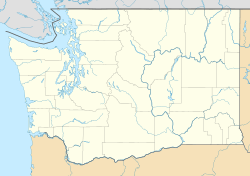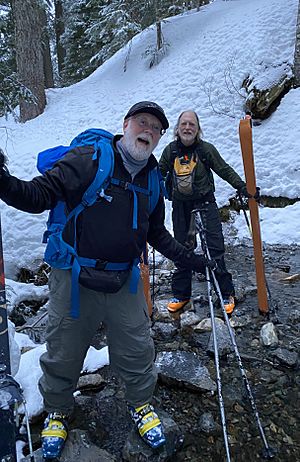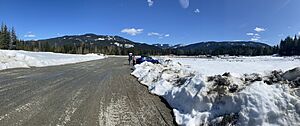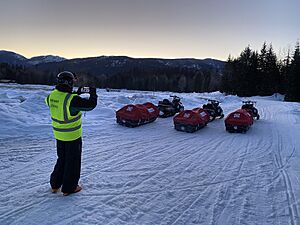Martin, Washington facts for kids
Quick facts for kids
Martin, Washington
|
|
|---|---|

Location sign for Martin, Washington
|
|
| Country | United States |
| State | Washington |
| County | Kittitas |
| Established | 1892 |
| Time zone | UTC-8 (Pacific (PST)) |
| • Summer (DST) | UTC-7 (PDT) |
Martin is a former town in the Pacific Northwest region of the United States. It is located in Kittitas County, Washington. The famous Stampede Pass is located nearby to the west. Today, Martin is known as a ghost town, meaning it is no longer inhabited.
What's in a Name?
The town of Martin got its name from a nearby stream called Martin Creek. This creek was first named Pine-Marten Creek. It got that name because an American marten (a small, furry animal like a weasel) was found and killed there a long time ago.
Martin's Railroad Story
Building the Railroad
Before the Stampede Tunnel was built, trains from the Northern Pacific Railroad (NP) had a tough time reaching the Puget Sound area from eastern Washington. They had to pay another railroad company to use their tracks. This route was long and involved a ferry ride across the Columbia River.
To avoid these costs, the NP decided to build a direct path over the Cascade Mountains. Engineers looked at three possible mountain passes: Snoqualmie Pass, Stampede Pass, and Naches Pass. By 1885, the railroad had reached Yakima, Washington. The NP was under pressure to build a direct line quickly, or they would lose valuable land.
So, they decided to drill the Stampede Tunnel. In January 1886, a man named Nelson Bennett won the contract to build the tunnel. His bid was much lower than others. On February 1, supplies began moving from Yakima to the tunnel site. It took months to clear trees and build roads for the heavy machines and supplies.
Once the supplies arrived, a construction camp was set up. It was called Tunnel City. Workers built bunkhouses, stables, a hospital, a restaurant, and even a saloon. From 1886 to 1888, over 200 workers lived there, building switchbacks (zigzag tracks) and drilling the tunnel. About 1,000 Chinese laborers also worked on the tunnel, camped higher up the hill.
In April 1886, the NP decided to build a temporary switchback over Stampede Pass. This was because the other railroad company was charging them more money. The switchback started at the Martin station and rejoined the main line after the tunnel. It was finished on June 1, 1887. Passenger trains started using it on July 3, and Martin became station No. 1894. In one month, 1,900 train cars used the switchback!
Winters in the Cascades brought huge amounts of snow, sometimes up to 10 feet deep. To protect the tracks, snowsheds were built along the line, including at Martin. These sheds were strong wooden tunnels. In January 1888, special steam snow shovels arrived to help clear the tracks.
The tunnel was finally finished on May 14, 1888, just seven days before the deadline! It opened for trains on May 28. The temporary switchback was then used for a few tourist trains before being closed down.
The Town's Decline
When steam trains were common, Martin was a very busy place. Railroad workers were there 24 hours a day. Martin was important for guiding trains through the single-track tunnel.
Over time, trains started using diesel engines instead of steam. This meant fewer workers were needed in Martin. By 1928, Tunnel City had mostly disappeared. Only a station house called Martin and a few small employee homes remained.
In February 1949, Martin experienced a massive snowstorm. Three feet of snow fell in one night! The total snow depth increased from 13 feet to 16 feet overnight. A crew of 124 men worked hard with snowplows to keep the line open.
In the late 1950s, the railroad installed a system called CTC (Centralized Traffic Control) at Easton. This system used machines to control train traffic through the tunnel, meaning even fewer people were needed at Martin. In April 1960, passenger trains stopped coming to Martin. By 1963, the Martin station was fully automated, and in 1964, all the railroad buildings there were torn down.
Abandonment and Restoration
In 1970, the Northern Pacific Railroad merged with other companies to form Burlington Northern (BN). BN had several routes across the Cascades, so the Stampede route became less important. In 1977, a storm washed out the tracks, and trains stopped running for a while.
On August 13, 1983, Burlington Northern stopped using the 78-mile railroad line that went through the Stampede Tunnel. They didn't completely give up the land, but no trains ran there. In July 1988, vandals caused a fire near the tunnel entrance at Martin. The fire destroyed part of the tunnel and hundreds of feet of track.
In 1995, Burlington Northern bought another railroad company and became BNSF. In 1996, BNSF announced plans to spend $125 million to fix the Stampede Pass route. About 500 workers installed new ties and rails. A new concrete snowshed was built at the Martin entrance of the tunnel. In December, trains started running through Martin again!
In 2019, BNSF added a signal tower at Martin. This allows them to run very long trains (up to 230 cars) of empty grain cars eastward through the tunnel. These long trains have engines at the front, middle, and back.
Other Features of Martin
A post office was opened in Martin in 1892, but it closed in 1902.
From at least 1934 to 1956, there was a fire lookout tower in Martin. This tower helped spot forest fires.
How to Get There
Today, you can reach Martin using the Palouse to Cascades State Park Trail. This trail crosses Forest Service road 54. You can get off at FS 54 and head west. Then, follow Forest Service road 420 west until the end.
Visiting in Winter
In winter, you can access Martin from the Crystal Springs Sno-Park. Forest Service road 54 is groomed for snow machines (like snowmobiles) on one side and for non-motorized activities (like skiing or sled dogs) on the other.
Visiting in Summer
In summer, you can drive to Martin. Take exit 62 off I-90. Then, take Forest Service road 54 to Forest Service road 420. Follow FS 420 to the end.
Fun Things to Do in Martin
Ski Touring
Starting in the early 1920s, skiers would ride the Northern Pacific Railroad to the Martin station. The railroad even provided warm bunk cars and meal cars on a side track at Martin. Skiers could stay overnight, and the railroad gave them heating stoves and free coal.
Meany Lodge
In 1928, a group called The Mountaineers built the Meany Ski Hut on land that was once part of Tunnel City. It was just a five-minute walk from the Martin train stop. The hut was later made bigger and is still used today as Meany Lodge.
Martin Ski Dome
In 1939, the Northern Pacific Railway opened a ski area near the eastern entrance of the Stampede Tunnel. It was called the Martin Ski Dome. It was right across the tracks from the Meany Ski Hut. The ski area closed in 1942 because of World War II. It was later sold and operated as the Husky Chalet until 1949.
Crystal Springs Sno-Park
The Crystal Springs Sno-Park is located just off Exit 62 on I-90. It's managed by Lake Easton State Park. This park provides access to many snow sports trails around Martin. The Sno-Park has plowed parking lots for different users: those who ski or use sled dogs, those who use snowmobiles, and people staying overnight at Meany Lodge or Trollhaugen.
Erling Stordahl Trailhead
The Erling Stordahl trailhead is very close to the Crystal Springs Sno-Park. It has flat, easy trails that are built and maintained by the Sons of Norway and the Ski for Light charity. These trails are specially designed for blind skiers, but everyone is welcome to use them.
Trollhaugen
A little further up the Stampede Pass road is the Cascade Sons of Norway lodge called Trollhaugen. The road here is groomed for both cross-country skiing (on the south side) and snowmobiling (on the north side).
Palouse to Cascades State Park Trail
Just over half a mile north of the Sno-Park, the Stampede Pass road crosses the Palouse to Cascades State Park Trail. This trail used to be called the John Wayne Pioneer Trail. In winter, the trail is groomed and is popular with skiers. In summer, bikers, hikers, and horse riders use the trail.
Sled Dogs
About a mile up Stampede Pass road, the trail for non-motorized activities (like skiing and sled dogs) follows Forest Road 420 to the left. Snowmobile traffic stays to the right. These cross-country ski trails are groomed by a machine named Hippo, which is owned and operated by volunteers from The Mountaineers club. This area is also where the Northwest Sled Dog Association holds their yearly Crystal Dog Challenge on the groomed trails.
At the very end of Forest Road 420, you'll find the historic location of Martin and the Meany Lodge ski resort.






